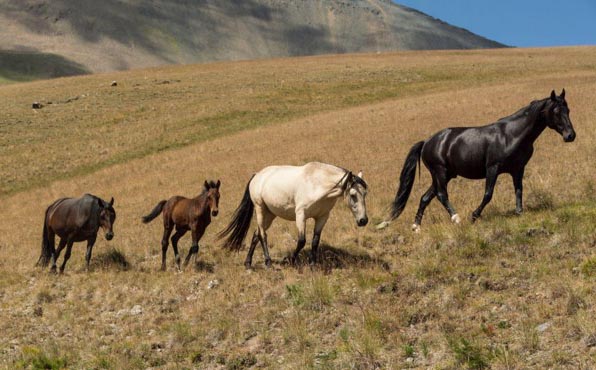This is a repost of an article originally featured on the Andi Carter website. Check it out here: https://andicartersblog.com/2023/06/05/icons-of-the-west/
Called “icons of the west” for their historical signification in the expansion towards the Pacific Ocean, mustangs are probably one of the most controversial topics in modern equine news today. The argument over the place of mustangs in today’s society has gone on for literally centuries, and will probably go on for centuries more.
The word “mustang” comes from the Spanish word mesteno, which means “feral.” Makes sense, because mustangs used to be the horses of Spanish soldiers, now gone wild.
Many of the horses still have that Spanish influence, especially in their heads. Most Spanish horses have what’s called a “barb” head– really just a fancy word for a roman nose.
This article will take you on a super quick tour around the USA to check out all of the different types of mustangs that live in our beautiful country. We’ll start with the type that started it all: the Spanish Colonial horse.
***

Spanish Colonial Horse
There are so many different types of mustangs, and all of them are beautiful. And they all descend from one breed: the Spanish Colonial Mustang.
Spanish Colonial Mustangs are believed to be the first Spanish horses whose influence is now all over the mustang herds. They are the state horse of North Carolina and are considered the purest of Spanish blood. They come in hundreds of colors and stand 13-15 hands. They are all over the southeast– even Florida has wild horses.
***

Pryor Mountain Mustangs
Pryor Mountain mustangs are said to be the most intelligent and hardy of the mustangs. They are also the easiest to train and legendary for their endurance and stamina. They live in the Pryor Mountain range in between Wyoming and Montana and stand 15 hands on average. Almost every color (except spotted) can be found in Pryor Mountain Mustangs
***

Cerbats
Cerbats are fine-boned mustangs from Arizona. They come in bay, roan, and chestnut, and stand about 14 hands. They are actually born with an ambling gait, and they are surefooted and calm. Many of them are gentled to make family horses.
***

Kiger Mustang
These mustangs live in southern Oregon and come mainly in dun and buckskin, with some bays, pintos, and blacks. Legend has it that Christopher Columbus brought Andalusian horses to America, but his soldiers traded them for small, hardy Sorraria horses from South America. The Andalusians and Sorraria bred together, creating the Kiger.
***

Chincoteague Pony
The east coast from Virginia to Florida has a surprising amount of wild ponies. The most famous, of course, is the Chincoteague pony. They live on the island of Assateague, but because they are sold on the smaller island of Chincoteague, they are called “Chincoteague” ponies. These ponies come in mostly chestnut, black, bay, palomino, and pinto colors, and measure 10 to 14 hands. They live in the salt marshes and are rounded up every summer for the foals to be auctioned off. All of the profit goes to help the fire department.
***

Shackleford Banker Pony
The Shackleford Banker Pony lives on the outer banks of North Carolina. They come in brown, bay, and chestnut, and stand 13-14 hands. They are small, friendly horses that will often come up to campsites looking for treats. There have been stories of Banker ponies pilfering food from campers.
***

Cumberland Island Horse
These ponies live on Cumberland Island in Georgia, but unlike the previous two, they aren’t doing as well. Mares don’t stick together very long, often bouncing between herds, and foals have a high mortality rate due to heat and poor food conditions. The sad life average for these horses is 9-10 years, often dying of sand colic or West Nile Virus. Efforts are being made to save the breed through captive breeding. They can be any solid colors and stand about 15 hands.
***

Florida Cracker Horse
Florida Crackers, otherwise known as Marsh Tackies, Florida Cow Ponies, Chickasaw Pony, and Seminole Pony, probably rank among Chincoteagues in prolificacy. These small, beautiful Spanish horses were once used to drive the small Cracker cattle in Florida, until the beef industry demanded larger cows and thus, larger horses. The 13-15 hand Cracker was almost forgotten until the late twentieth century, when people began to conserve this breed. Today there are a little over 1,000 horses. They mostly come in gray, but they can be any color. They are mostly found in the Ocala region of Florida, and were voted the state horse in 2008.
***
And we’ve come to the end of the tour. No matter what you may believe about mustangs and their freedom, I think we can all agree that they are excellent horses, and wonderfully designed by a Creator who loves His creation.
If you could choose one mustang type to have as your own, what would it be?

Wow, this is really cool! I ride a mustang that was taken from the wild, so this was great information to know!